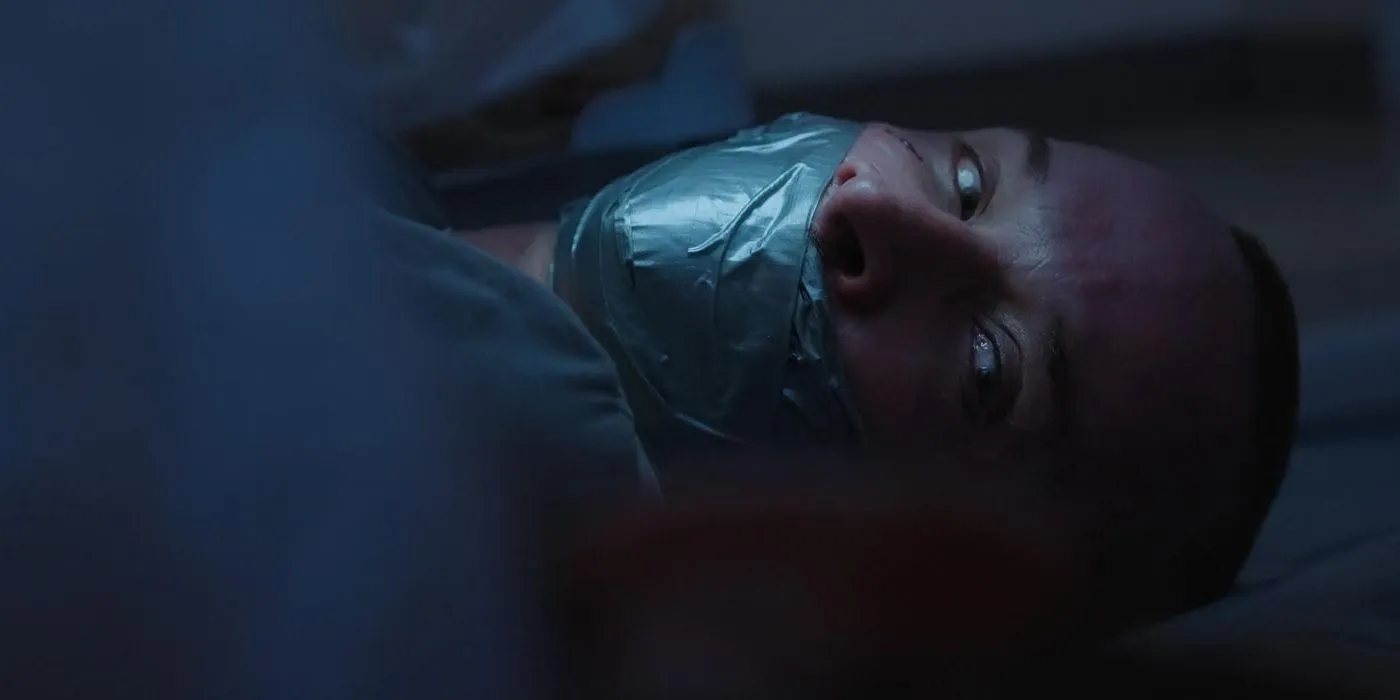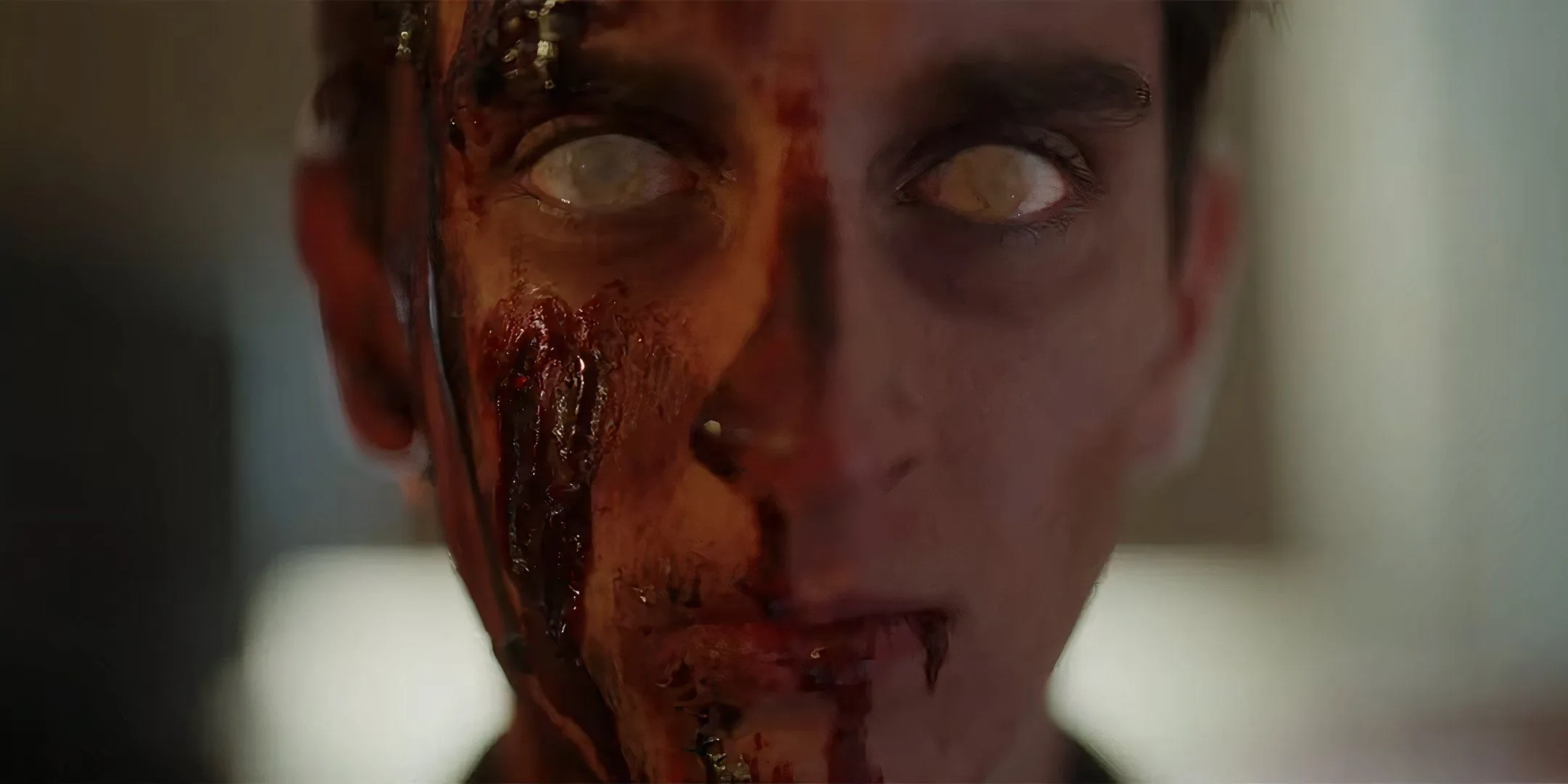He Never Left is an interesting horror film because it tries to be both a slasher horror movie and a philosophical drama simultaneously. Most horror movies these days follow the same tired formulae. This film, released amid the clamor of the genre’s most recent offers, transports viewers to the eerie world of Larsen City, a town haunted by both the ghosts of its residents’ pasts and the specter of a masked killer. The film’s narrative focuses on Gabriel, a runaway stuck between guilt and despair and trying to find safety in a motel that serves as both a safe place to stay and a prison.
James Morris, who wrote the script with Michael Ballif and Colin Cunningham, directed He Never Left, which defies the tropes of conventional slasher films. It weaves together the psychological battles of its characters with visceral horror, presenting a Gothic tapestry that elevates the genre beyond shock value.
The plot of the film—an ex-con dealing with his violent past while a serial killer reappears—explores the tension between personal redemption and social condemnation, offering a fertile ground for thematic exploration. This film is a brave mix of horror and character study. It asks: Are the monsters around us or inside us what scares us?
Threads of Desperation: The Duality of Fear in He Never Left
The narrative of He Never Left takes place in the creepy rooms of a small-town motel, where Gabriel, a runaway criminal with a history of bad behavior, tries to find peace amid chaos. The film transports viewers to Larsen City, a place rife with unease and where the air is thick with the ghosts of a sinister past.
In a world that won’t forget, Gabriel’s situation is more than just a matter of avoiding the law. It’s also a last-ditch effort at redemption. His character is carefully woven into the trauma of the town, presenting a moving portrait of a man dealing with the consequences of a violent accident that left him physically and mentally scarred.
The specter of the Pale Face killer, a malevolent force that reawakens the town’s suppressed fears, grows bigger as Gabriel battles his internal demons. The killer’s return serves as both a cause for horror and a reflection of Gabriel’s monstrous potential.
The killer’s reign of terror and Gabriel’s quest for escape create a tension-filled dynamic that questions the nature of evil itself. In this case, the lines between hunter and hunted become less clear, showing that the real horror may not be in the killer’s blade but in the shadows of one’s guilt.
Shadows and Mirrors: The Complexity of Character in He Never Left
The character Gabriel Gaspari, whose rocky path symbolizes the film’s study of guilt, redemption, and the human condition, is at the center of He Never Left. Gabriel, played by Colin Cunningham with haunting intensity, is more than just a wanted person; he is a broken soul caught in the consequences of a terrible accident.
He has many motivations, from a strong need to escape to a deep desire to make things right. The narrative progresses, allowing viewers to see Gabriel’s inner fight as he deals with the weight of his past—a hit-and-run that has changed his life forever. This duality serves as a sobering warning that the road to redemption is frequently fraught with danger and self-doubt.
Carly, played by Jessica Staples, is Gabriel’s partner and mental support. Her character shows the complexities of surviving in a world that often pushes people who have failed to the edges. Carly, an ex-con and recovering addict, mirrors Gabriel’s struggles and provides an important emotional balance. As she deals with her problems while helping Gabriel on his quest, her presence adds a layer of humanity to the narrative. Staples portrays Carly as a frail woman torn between her duty to her family and her quest for a better life.
The U.S. Marshals and the motel staff are examples of supporting characters who serve as a backdrop to Gabriel and Carly’s problems and heighten the tension in the film. These characters aren’t just there to help the story along; they also reflect the judgment that the protagonists face from society.
The Marshals exemplify the unwavering chase of justice, but their work begs questions about the nature of morality in a world where everyone has secrets. The motel staff, especially Bryce, adds another layer of unease by suggesting that danger can be found in the shadows and places meant to provide shelter. Viewers confront the complexities of human weakness and redemption in this patchwork of characters in He Never Left’s emotionally rich narrative.
Echoes of Guilt: The Thematic Depth of He Never Left
The central themes of guilt and redemption are explored in He Never Left movingly, creating a narrative that will strike home for anyone who has ever struggled with their past. As he faces the lingering shadows of a terrible accident that has ruined his life, Gabriel’s journey is a metaphor for a quest for self-forgiveness.
The film shows viewers how to make their way through the difficult seas of regret with Gabriel. His internal struggles are a strong reminder that the path to redemption is fraught with emotional upheaval and frequently requires confronting the ghosts that won’t go away.
The film also shows how hard it is for ex-convicts to get along with others, which makes Gabriel’s situation even worse. The narrative shows the harsh realities of reintegration and shows how the world is often not forgiving to people who have done wrong.
This look at societal stigma is especially important because it shows how systemic hurdles make it hard for people to take back their lives. The film shows how deeply people feel when their pasts affect them through Gabriel and Carly. It makes us think about how we can help each other and how things can change.
In contrast, the Pale Face killer is used to look at the nature of evil in detail. Gabriel struggles with his moral flaws, while Pale Face is a heartless villain who greatly changes their motivations. What distinguishes a flawed person seeking redemption from a relentless predator? This dichotomy raises unsettling questions about the nature of humanity. As the film progresses, it challenges the audience to reflect on the complexities of action, eventually suggesting that the true horror lies not in the actions of the monstrous but in the choices that define our humanity.
Framing Fear: The Visual Language of He Never Left
In He Never Left, the motel setting serves as a character in and of itself, a claustrophobic haven that heightens the film’s tension and sense of dread. The motel, tucked away in the disquiet of Larsen City, exudes a sense of decay that mirrors Gabriel’s broken mind.
Each room is a miniature of loneliness, with thin walls that make the sounds of horror from the room next door louder, raising the stakes for our main character. This architectural representation of being trapped is masterfully used to build suspense, as the viewer is aware that safety is only an illusion.
With Michael Ballif’s lens capturing both the beauty and brutality of the setting, cinematography plays a crucial role in creating the film’s aesthetic. The interaction of light and shadow becomes especially evocative, highlighting the moral ambiguities throughout the narrative.
The chiaroscuro method creates a sense of dread in dark corners, while stark contrasts bring Gabriel to moments of emotional clarity. The camera moves carefully and often stays on Gabriel’s expressive face for a long time, letting viewers see through his problems. The vivid compositions contrast the peaceful fall landscapes with the suffocating motel rooms, creating a visual dissonance that mirrors the tensions in the film’s themes.
The careful arrangement of images not only strengthens the horror parts but also draws viewers into the characters’ minds, creating a link between the looks of fear and the feelings of guilt and redemption. The cinematography in He Never Left goes beyond just showing; it becomes an experience that makes viewers confront the shadows inside and outside of them.
The Rhythm of Dread: Pacing and Structure in He Never Left
Particularly in the film’s first two acts, the pacing in He Never Left becomes both a problem and a crucial narrative tool. The slow burn method enables a close examination of Gabriel’s mental environment, gradually revealing his internal conflicts against the backdrop of impending external threats.
This slow, deliberate pace creates a palpable tension that makes viewers want to dwell on how unknown Gabriel’s fate is. However, the film sometimes falls into a slow rhythm that loses the audience’s attention as it wanders through information that would benefit from being more focused.
The narrative hits a critical point as it nears its climax, but this rise in tension doesn’t feel quite right. The film’s ending tries to be a release, but the pace problems make it feel like it’s not quite the end. The encounter with the Pale Face killer doesn’t feel like the culmination of the growing fear; instead, it feels rushed and lacks the weight one would expect after such a long buildup.
This hole in the narrative makes the audience want a stronger ending where the stakes are as high as the narrative suggests. Even though the last few minutes try to tie together the themes of guilt and redemption, they might just feel like a repeat of the tension that came before them instead of the explosive buildup that one would expect.
The Convergence of Nightmares: Horror and Genre in He Never Left
Takes care when it comes to horror, especially when it comes to the killer parts, which are both physically and mentally disturbing. Violence is portrayed not just for show but also to reflect the characters’ inner turmoil. The film avoids gratuitous blood and guts in favor of a more subtle approach, in which each act of violence carries weight from Gabriel’s past.
By making the killer’s actions a terrifying embodiment of Gabriel’s fears and regrets, this deliberate restraint heightens the horror and elevates the narrative above and beyond shock value.
The film also shines when it mixes genres, expertly mixing slasher and crime drama elements. As his trip is intertwined with the investigation into the Pale Face killer, the psychological complexity of Gabriel’s character provides a rich backdrop for the unfolding horror.
The raw terror of slasher tropes is infused into the suspense of a traditional crime drama, creating a multilayered narrative that forces viewers to engage with both the mysteries of the plot and the complexities of human frailty. This blending of genres calls for reevaluating genre norms, suggesting that horror can serve as a profound commentary on guilt, horror, and the darkest parts of the human mind rather than just being a genre for thrills.
The Review
He Never Left
He Never Left is a haunting story about guilt and redemption that skillfully mixes slasher horror and crime drama elements. The film's moody setting and complicated relationships between characters create a rich weave of psychological tension, though the climax's slow pace takes away from some of its power. While the motel serves as a spooky backdrop to Gabriel's battle, Colin Cunningham's portrayal of him is the narrative's driving force. The film ultimately pushes the limits of the genre by offering a provocative analysis of morality in the face of terror.
PROS
- Strong character development, particularly in Gabriel and Carly.
- Atmospheric setting that enhances tension and dread.
- Thought-provoking themes of guilt and redemption.
CONS
- Pacing issues, particularly in the climax.
- Some narrative elements may feel meandering.
- The resolution lacks the expected emotional weight.





















































